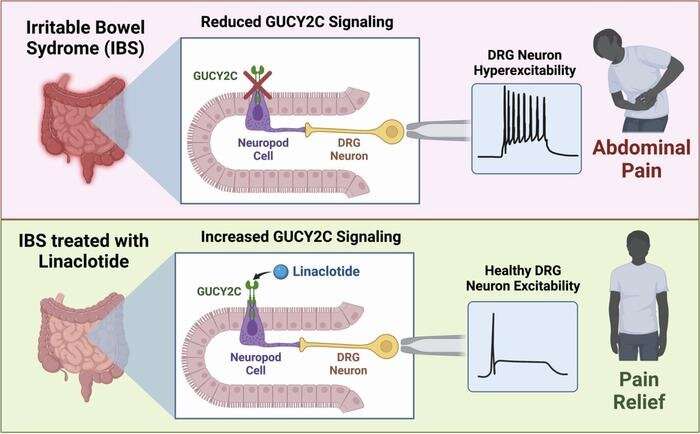
An approved drug for chronic constipation also relieves the pain associated with that condition. New research by Scott Waldman, MD, Ph.D., chair of pharmacology, physiology and cancer biology at Jefferson, demonstrates that the drug’s two actions can be separated biologically—a finding that may offer ways to precisely target visceral pain syndromes beyond constipation.
Here’s what was known: A receptor molecule called GUCY2C, present in the lining of the intestines, regulates water and salt balance, and therefore, the looseness of stools. The constipation medicine, called linaclotide, acts on this receptor to increase water secretion. However, the drug’s pain-relieving action does not appear to be a simple consequence of constipation relief, and hypotheses abounded as to how it all worked.
Dr. Waldman and his MD-Ph.D. student Joshua Barton sought to explore how the drug produced analgesia. The study, published in the Journal of Clinical Investigation focused on the GUCY2C receptor in a newly discovered intestinal cell type called neuropods, which can sense stimulation and communicate closely with neurons that send pain messages to the brain. The team partnered with neuroscientist Manuel Covarrubias, MD, Ph.D., who co-directed the study.
The researchers used molecular tools to delete GUCY2C receptors from neuropods in mice, but not from other intestinal cells. The altered animals experienced spontaneous visceral pain that the drug linaclotide did not relieve; meanwhile water secretion was unaffected. This finding, Dr. Waldman says, means that neuropod receptors are regulating sensory tone in the intestine and that they mediate the drug effect on pain.
What was most surprising, he says, is how stark the delineation was. Biological functions are known for redundancies and exploratory scientific research doesn’t often yield such clear results—in this case, separating two seemingly connected functions, pain relief and water secretion.
Dr. Waldman envisions therapies that directly target neuropod cells. “We may be able to side-step a major side effect—diarrhea—in other visceral pain conditions,” he says, such as irritable bowel syndrome with diarrhea or endometriosis. Visceral pain regulation by neuropods may represent “a final common pathway,” he says.
Thomas Jefferson University

